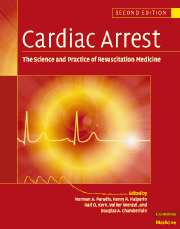Book contents
- Frontmatter
- Contents
- List of contributors
- Foreword
- Preface
- Part I Introduction
- Part II Basic science
- Part III The pathophysiology of global ischemia and reperfusion
- 12 The etiology of sudden death
- 13 Global brain ischemia and reperfusion
- 14 Reperfusion injury in cardiac arrest and cardiopulmonary resuscitation
- 15 Visceral organ ischemia and reperfusion in cardiac arrest
- 16 Mechanisms of forward flow during external chest compression
- 17 Hemodynamics of cardiac arrest
- 18 Coronary perfusion pressure during cardiopulmonary resuscitation
- 19 Methods to improve cerebral blood flow and neurological outcome after cardiac arrest
- 20 Pharmacology of cardiac arrest and reperfusion
- 21 Analysis and predictive value of the ventricular fibrillation waveform
- 22 Etiology, electrophysiology, and myocardial mechanics of pulseless electrical activity
- Part IV Therapy of sudden death
- Part V Postresuscitation disease and its care
- Part VI Special resuscitation circumstances
- Part VII Special issues in resuscitation
- Index
16 - Mechanisms of forward flow during external chest compression
from Part III - The pathophysiology of global ischemia and reperfusion
Published online by Cambridge University Press: 06 January 2010
- Frontmatter
- Contents
- List of contributors
- Foreword
- Preface
- Part I Introduction
- Part II Basic science
- Part III The pathophysiology of global ischemia and reperfusion
- 12 The etiology of sudden death
- 13 Global brain ischemia and reperfusion
- 14 Reperfusion injury in cardiac arrest and cardiopulmonary resuscitation
- 15 Visceral organ ischemia and reperfusion in cardiac arrest
- 16 Mechanisms of forward flow during external chest compression
- 17 Hemodynamics of cardiac arrest
- 18 Coronary perfusion pressure during cardiopulmonary resuscitation
- 19 Methods to improve cerebral blood flow and neurological outcome after cardiac arrest
- 20 Pharmacology of cardiac arrest and reperfusion
- 21 Analysis and predictive value of the ventricular fibrillation waveform
- 22 Etiology, electrophysiology, and myocardial mechanics of pulseless electrical activity
- Part IV Therapy of sudden death
- Part V Postresuscitation disease and its care
- Part VI Special resuscitation circumstances
- Part VII Special issues in resuscitation
- Index
Summary
There are more than 300 000 victims of cardiac arrest each year, and attempts to resuscitate them are usually unsuccessful. Laboratory and clinical studies have shown that restoration of cardiac function after cardiac arrest is related to the level of coronary perfusion generated during resuscitation. It has also been shown that adequate cerebral perfusion is necessary for preservation of brain function. There is therefore a critical need for determining methods to augment blood flow generated during resuscitation. A key factor in enhancing flow is understanding the mechanisms of blood flow operative during chest compression, since it may be possible to optimize flow by exploiting those mechanisms.
Fluid movement in any hydraulic system results from the interaction of a pump, or driving force for fluid movement, and a load. In the intact cardiovascular system, the pump is obviously the heart, and the load is the vascular resistance and compliance. During resuscitation, however, the pump and load are less well defined. Continuing controversy exists over the nature of the pump operative during chest compression. Pumps that have been proposed include direct cardiac compression, intrathoracic pressure rises, and a combination of both. It is important to determine the nature of the pump, since the method of chest compression for optimizing flow may be different depending on which pump is operative.
For optimizing flow, it may also be important to understand the effects of a number of techniques that have been investigated which may modify the pump.
- Type
- Chapter
- Information
- Cardiac ArrestThe Science and Practice of Resuscitation Medicine, pp. 326 - 346Publisher: Cambridge University PressPrint publication year: 2007

